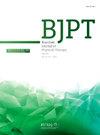Effects of aerobic, resistance, and combined exercises on ventilatory function and quality of life in men with chronic post-COVID pulmonary fibrosis: A randomized controlled trial
IF 3.2
3区 医学
Q1 ORTHOPEDICS
引用次数: 0
Abstract
Background
Different exercises have gained much interest for managing post-COVID-19 pulmonary fibrosis (PC19-PF).
Objective
To compare the impacts of aerobic, resistance, and combined exercises on ventilatory function, lung fibrosis, exercise capacity, and quality of life (QoL) in men with chronic PC19-PF.
Methods
Eighty males with chronic PC19-PF aged 40–60 were randomly assigned to four groups: aerobic exercise (AE), resistance exercise (RE), AE/RE, and a control group. Outcomes included forced vital capacity (FVC), diffusing capacity of the lungs for carbon monoxide (DLCO), fibrosis grade by computed tomography, exercise capacity using the estimated maximal oxygen consumption (VO2max), dyspnea using the Medical Research Council (MRC) dyspnea scale, and QoL using the 12-item Short Form Health Survey (SF-12).
Results
For all outcome measures, significant group by time interactions were noted (p < 0.05). The AE and AE/RE groups demonstrated significant improvements in all outcomes compared to controls (p < 0.05), with no notable differences between the two groups, except for the estimated VO2max, in favor of AE (p = 0.04). Compared to controls, RE significantly improved the estimated VO2max, dyspnea (MRC scale), and QoL (p < 0.05) with no effects on FVC, DLCO, or fibrosis grade (p > 0.05). In addition, compared to RE, both AE and AE/RE significantly improved all outcomes (p < 0.05).
Conclusion
In men with chronic PC19-PF, both AE and AE/RE could similarly improve ventilatory function, lung fibrosis, dyspnea, and QoL, with AE improving exercise capacity most.
有氧、阻力和联合运动对男性慢性肺炎后肺纤维化患者通气功能和生活质量的影响:一项随机对照试验
不同的锻炼方式对治疗covid -19后肺纤维化(PC19-PF)引起了很大的兴趣。目的比较有氧运动、阻力运动和联合运动对男性慢性PC19-PF患者通气功能、肺纤维化、运动能力和生活质量的影响。方法40 ~ 60岁慢性PC19-PF男性80例,随机分为有氧运动组(AE)、阻力运动组(RE)、AE/RE组和对照组。结果包括用力肺活量(FVC)、肺一氧化碳弥散量(DLCO)、计算机断层扫描纤维化等级、估计最大耗氧量(VO2max)的运动能力、医学研究委员会(MRC)呼吸困难量表的呼吸困难和12项简短健康调查(SF-12)的生活质量。结果对于所有的结果测量,注意到显著的组间时间相互作用(p <;0.05)。与对照组相比,AE组和AE/RE组的所有结果均有显著改善(p <;0.05),两组间除估计的最大摄氧量外,无显著差异,支持AE (p = 0.04)。与对照组相比,RE显著改善了估计的最大摄氧量、呼吸困难(MRC量表)和生活质量(p <;0.05),对FVC、DLCO或纤维化等级无影响(p >;0.05)。此外,与RE相比,AE和AE/RE均显著改善了所有结果(p <;0.05)。结论在慢性PC19-PF患者中,AE和AE/RE对通气功能、肺纤维化、呼吸困难和生活质量的改善作用相似,其中AE对运动能力的改善作用最大。
本文章由计算机程序翻译,如有差异,请以英文原文为准。
求助全文
约1分钟内获得全文
求助全文
来源期刊
CiteScore
6.10
自引率
8.80%
发文量
53
审稿时长
74 days
期刊介绍:
The Brazilian Journal of Physical Therapy (BJPT) is the official publication of the Brazilian Society of Physical Therapy Research and Graduate Studies (ABRAPG-Ft). It publishes original research articles on topics related to the areas of physical therapy and rehabilitation sciences, including clinical, basic or applied studies on the assessment, prevention, and treatment of movement disorders.

 求助内容:
求助内容: 应助结果提醒方式:
应助结果提醒方式:


